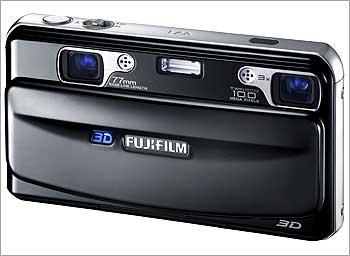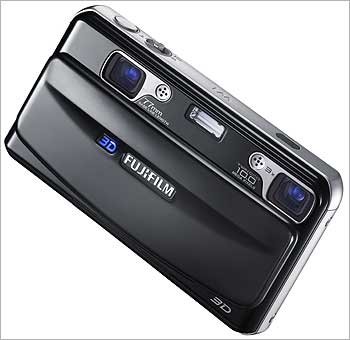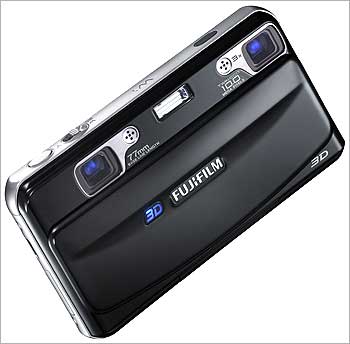
The 3D system consists of FinePix REAL 3D W1, the 3D camera, an 8-inch viewer on which 3D images can be displayed, and 3D print, that helps users print 3D images.
Priced at Rs 39,999, the camera has twin lenses, twin sensor technology and is equipped with a processor capable of blending two separate images to create a single, three-dimensional effect.
Fujifilm aims to be one of the top digital camera brands in India and acquire 15 per cent market share in three years. So how does a 3D camera work? Find out. . .

For a 3D image, two images need to be layered together. Thus, 2 Fujinon lenses are installed in this camera.
A 3D camera simultaneously takes a picture from two slightly different angles or positions: the distance separating your eyes which are about 2.5 inches apart. When the two images are seen again by each eye through a viewer or with special glasses, the brain interprets everything to be as it originally was -- and so the 'realism' is created.
In the 'Individual Shutter 3D Shooting' mode, the camera takes two shots, one after the other, and saves a single 3D image in the camera manually.
The 3D image generated can be edited and this is particularly useful for landscape photography where a 3D image is difficult to achieve, or conversely, macro shots, where the 3D effect can be good.
In the 'Interval 3D Shooting' mode, it is possible to take two shots from different viewpoints continuously while the photographer is moving, for example by train, plane, or car, etc, to capture 3D images of long-distance views.
Kenichi Tanaka, managing director, Fujifilm India, says "We will continue to introduce digital camera models that are either world's first in some aspect, are award winning or based on an innovative technology that's exclusive to Fujifilm."

Adjustable in both live images on LCD panel while shooting and recorded images, this simplicity-of-use lets users really get creative.
This camera also brings new possibilities in 2D photography owing to the fact that it is actually two digital cameras rolled into one.
Its 'Advanced 2D Mode' lets users take two different shots simultaneously by pressing the shutter once.
With 'Tele/Wide Simultaneous Shooting' mode, it is possible to take a close-up photo of the subject and, at the same time, a photo with a wider span (wide angle) - just by changing the settings of the two lenses.
With '2-Color Simultaneous Shooting' mode, users can take photos of the same scene with different colour tonalities. Besides, 13 different types of scene position are featured that enable users to enjoy various shooting styles in 2D and 3D.

In scenes where it is difficult to determine the optimal camera settings, users can take shots with picture stabilization priority and then with picture quality priority and choose the best image later, or change the picture stabilisation levels to take two different shots simultaneously.
Users can simply insert the SD memory card, in which 3D images (or videos) have been saved, into the 3D viewer and enjoy a 3D slideshow. They can be in complete control using the intuitive remote control.
If the 'Parallax Control' is used, users can adjust the 3D effect on the viewer manually. The 3D viewer has easy-to-use features like Micro Thumbnail View and 'Image Search'.
It can also receive image data via high-speed IR (infrared) communication. Users can also directly connect it to their PC via USB and transfer stored images to the viewer for display.